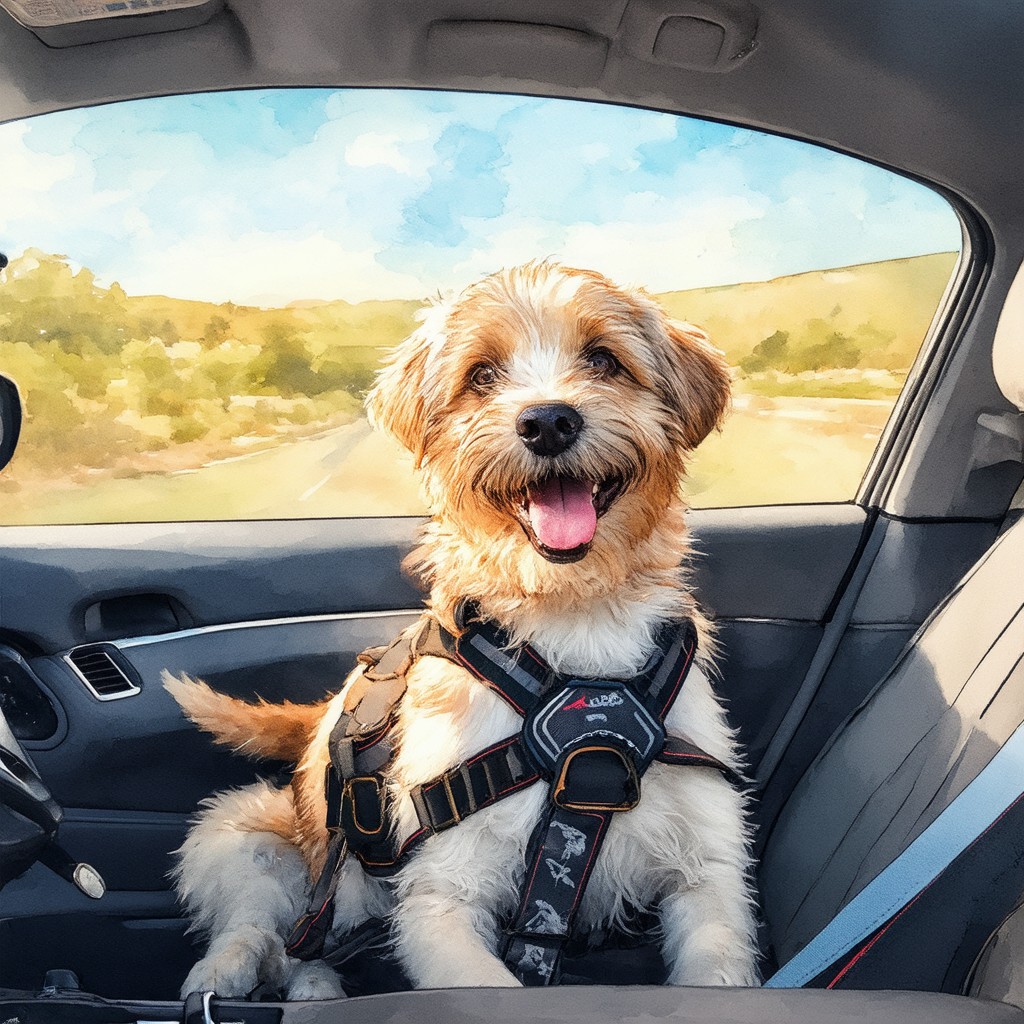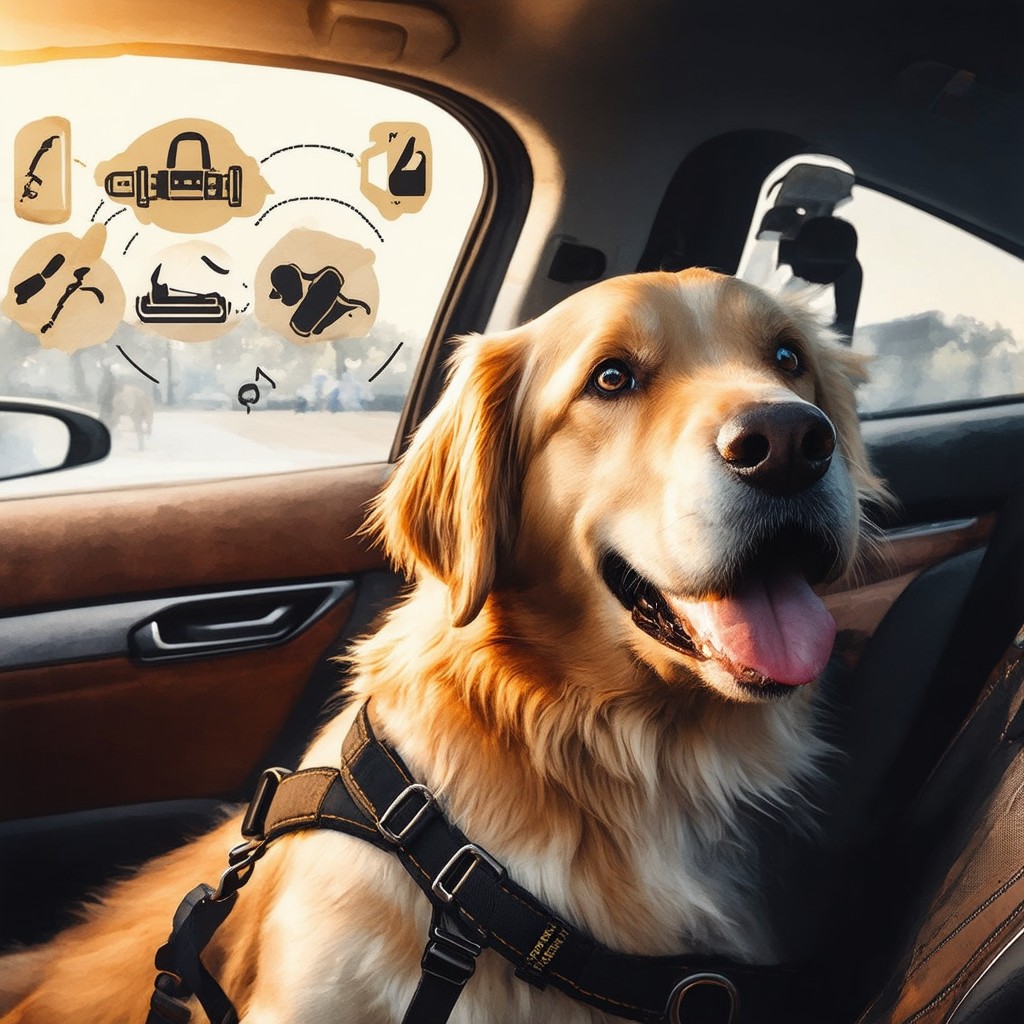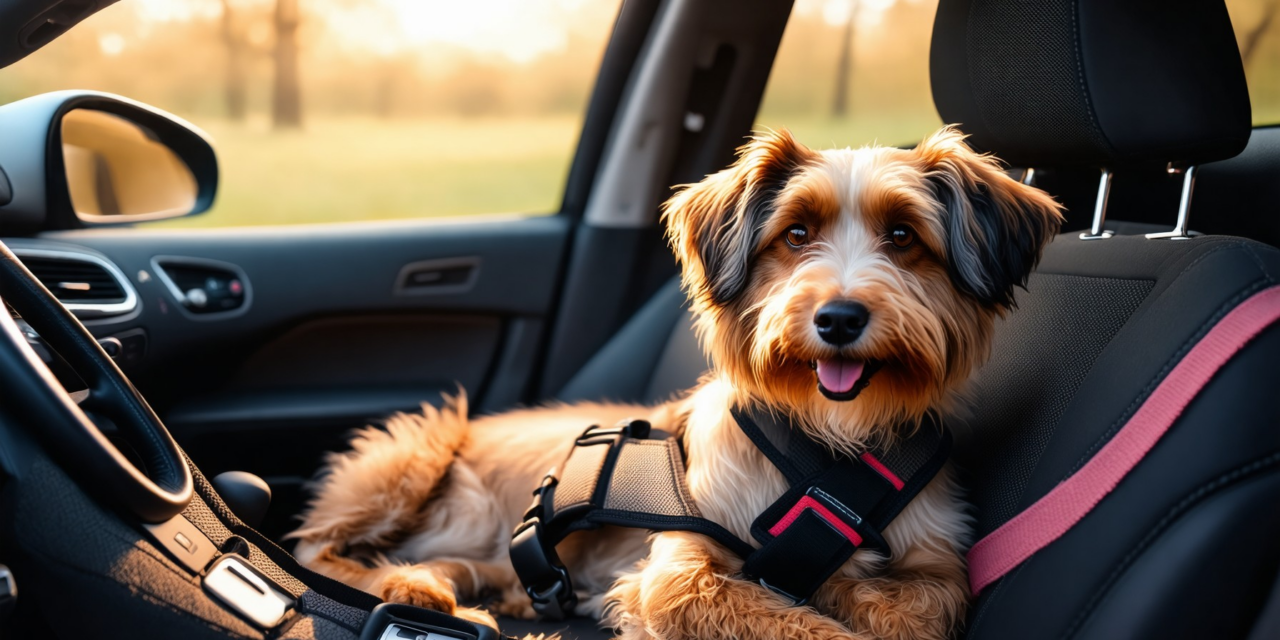Key Takeaways
- Safety First: Always use a crash-tested dog car harness to ensure your pet’s safety during travel.
- Legal Compliance: Many regions require dogs to be securely restrained while traveling, making a dog seat belt not just safe but necessary.
- Enhanced Comfort: A well-fitted harness allows dogs to sit, stand, or lie down comfortably, reducing anxiety during long trips.
- Training is Key: Properly train your dog to wear a harness to improve their comfort and reduce travel stress.
- Expert Recommendations: Brands like Kurgo and Sleepypod offer top-rated crash-tested harnesses for optimal protection.
When it comes to ensuring the safety of your furry friend during car rides, choosing the right dog car harness is crucial. In this comprehensive guide, we will explore essential insights on why every dog should wear a harness in a car, the benefits of using a dog seat belt, and the various options available, including crash-tested dog harnesses. We will delve into expert recommendations on the safest ways for your dog to travel, comparing different restraint systems such as dog seat belt harnesses and traditional harnesses. Additionally, we will provide valuable tips on selecting the best dog car harness for large dogs, ensuring comfort without compromising safety. By the end of this article, you will be equipped with the knowledge to make informed decisions about your pet’s travel safety, including reviews of the top-rated crash tested dog car harnesses on the market. Join us as we navigate the world of dog restraints and uncover the best practices for transporting your beloved pet securely.
Should dogs wear a harness in a car?
Understanding the Importance of Dog Restraints
Yes, dogs should wear a harness in a car for several important reasons:
- Safety and Restraint: A properly fitted harness helps to restrain your dog, preventing them from moving around the vehicle, which can distract the driver. According to the American Kennel Club (AKC), unrestrained dogs can become projectiles in the event of a sudden stop or accident, leading to serious injuries for both the dog and passengers.
- Legal Requirements: In many regions, including the UK, it is a legal requirement to ensure that pets are suitably restrained while traveling in a vehicle. The Highway Code states that dogs must be restrained to avoid distractions and potential harm. Failure to comply can result in fines and penalties.
- Comfort and Security: Harnesses are designed to distribute pressure evenly across a dog’s body, reducing the risk of injury during sudden movements. They provide a sense of security for anxious dogs, making car travel more comfortable. A study published in the Journal of the American Veterinary Medical Association highlights that dogs secured in harnesses are less likely to experience anxiety during travel.
- Types of Harnesses: There are various types of harnesses available, including those specifically designed for car travel. Look for crash-tested harnesses that meet safety standards, such as those certified by the Center for Pet Safety. These harnesses are designed to withstand the forces of a car crash, ensuring maximum protection for your pet.
- Training and Adaptation: It’s essential to train your dog to wear a harness comfortably. Gradually introduce the harness in a positive manner, allowing your dog to associate it with enjoyable experiences. This can help reduce anxiety and improve their overall travel experience.
For more detailed guidance on pet travel safety, you can refer to resources from the RSPCA and the American Society for the Prevention of Cruelty to Animals (ASPCA). Ensuring your dog wears a harness in the car is not just a matter of compliance; it is a crucial aspect of responsible pet ownership that prioritizes the safety of your furry friend and all passengers.
Benefits of Using a Dog Car Harness
Using a dog car harness offers numerous benefits that enhance both safety and comfort during travel:
- Enhanced Safety: A dog car harness is specifically designed to keep your pet secure during sudden stops or accidents. Crash-tested dog harnesses provide an additional layer of protection, ensuring that your dog remains safely restrained.
- Reduced Distractions: By using a dog seat belt harness, you minimize the chances of your dog moving around the vehicle, which can distract the driver and increase the risk of accidents.
- Versatility: Many dog harnesses for cars can also be used for walking, making them a multifunctional option for pet owners. This adaptability can save you money and reduce the need for multiple products.
- Improved Comfort: A well-fitted dog harness distributes pressure evenly, making it more comfortable for your dog during travel. This is especially important for long journeys, where comfort can significantly impact your dog’s experience.
- Peace of Mind: Knowing that your dog is safely secured allows you to focus on driving without worrying about your pet’s safety. This peace of mind is invaluable for any pet owner.
For a reliable option, consider the Kurgo dog car harness, which is known for its durability and safety features. Investing in a quality dog car harness is a proactive step towards ensuring your pet’s safety on the road.

What is the best restraint for a dog in a car?
When considering the best restraint for a dog in a car, safety and comfort are paramount. Here are the top options:
- Dog Harness: A high-quality dog harness is widely regarded as the safest restraint method. Look for crash-tested harnesses that distribute force evenly across the dog’s body, reducing the risk of injury during sudden stops or accidents. Brands like Kurgo and Sleepypod offer harnesses designed specifically for vehicle safety.
- Dog Crate: For crate-trained dogs, a sturdy dog crate can be an excellent option. Ensure the crate is well-ventilated and secured in the vehicle to prevent it from moving during travel. While crates can be bulky, they provide a secure environment that can help reduce anxiety in dogs.
- Dog Seatbelt: A dog seatbelt is another effective restraint. These devices attach to your car’s seatbelt system and clip onto your dog’s harness. They allow for some movement while keeping your dog secure. Look for adjustable options that can accommodate different dog sizes.
- Pet Barrier: If you have a larger vehicle, a pet barrier can keep your dog safely in the back seat. This option is particularly useful for preventing distractions while driving. Ensure the barrier is sturdy and properly installed to avoid any accidents.
- Safety Tips: Regardless of the restraint method chosen, always ensure your dog is comfortable and accustomed to the restraint before embarking on longer journeys. Gradually acclimate your dog to the car and the restraint system to reduce anxiety.
For further reading on pet safety during travel, consult resources like the American Kennel Club (AKC) and the Center for Pet Safety, which provide valuable insights and recommendations based on recent studies and expert opinions.
Overview of Dog Car Harness Options
When selecting a dog car harness, it’s essential to consider various options available in the market. Here are some popular choices:
- Kurgo Enhanced Strength Tru-Fit Dog Car Harness: This harness is designed for safety and comfort, featuring crash-tested technology that ensures your dog’s security during travel. It also doubles as a walking harness, making it versatile for daily use.
- Ruffwear Load Up Harness: Known for its durability, this harness is perfect for adventurous dogs. It provides a secure fit and is easy to put on and take off, making it ideal for frequent travelers.
- Sleepypod Clickit Sport Dog Safety Harness: This harness is designed with safety in mind, featuring a three-point design that keeps your dog secure in the event of an accident. It’s crash-tested and offers a comfortable fit for your pet.
- PetSafe Happy Ride Dog Safety Harness: This affordable option provides a secure fit and is easy to use. It’s designed to work with your car’s seatbelt system, ensuring your dog stays safe and comfortable.
Choosing the right car harness for dogs can make a significant difference in your pet’s safety during travel. Always look for harnesses that have been crash-tested to ensure maximum protection.
What is the safest way for a dog to ride in a car?
The safest way for a dog to ride in a car is to ensure they are properly secured to prevent injury during travel. Here are the best practices:
- Use a Crate: A sturdy, well-ventilated crate designed for travel is the safest option. It should be secured in the back seat to prevent it from moving during sudden stops or accidents. The crate should be large enough for the dog to stand, turn around, and lie down comfortably.
- Dog Seat Belt Harness: If a crate is not an option, a dog seat belt harness is a great alternative. This harness attaches to the car’s seatbelt system, keeping your dog secure while allowing them some movement. Ensure the harness is crash-tested for safety.
- Avoid the Front Seat: Dogs should never ride in the front seat due to the risk of airbag deployment, which can cause serious injury. The back seat is the safest place for your pet.
- No Riding in the Driver’s Lap: This practice is dangerous as it can distract the driver and increase the risk of accidents. Dogs should always be secured in the back seat.
- Keep Windows Closed: While dogs may enjoy the breeze, riding with their head out the window poses significant risks, including injury from debris or jumping out of the vehicle. Keep windows closed or only slightly open for ventilation.
- Regular Breaks: On long trips, take regular breaks to allow your dog to stretch, relieve themselves, and hydrate. This helps reduce anxiety and restlessness during travel.
- Familiarize Your Dog with Car Travel: Gradually acclimate your dog to car rides by taking them on short trips. This can help reduce anxiety and make them more comfortable during longer journeys.
For more detailed guidance on pet safety during travel, consider consulting resources from organizations like the American Kennel Club (AKC) or the Humane Society. Implementing these practices not only ensures your dog’s safety but also contributes to a more enjoyable travel experience for both you and your pet.
Crash-Tested Dog Harnesses: Why They Matter
When selecting a dog car harness, it’s crucial to choose one that has been crash-tested. Crash-tested dog harnesses are designed to withstand the forces of a collision, providing maximum protection for your pet. These harnesses are rigorously evaluated to ensure they can keep your dog secure during an accident, significantly reducing the risk of injury.
Some of the best dog car harness options include the Kurgo dog car harness, known for its durability and safety features. Additionally, the Center for Pet Safety provides valuable information on crash-tested dog harnesses, helping pet owners make informed decisions.
Investing in a crash-tested dog harness not only enhances your pet’s safety but also gives you peace of mind while traveling. Always look for harnesses that meet safety standards and have been independently tested for crash safety.
Best Practices for Securing Your Dog in the Vehicle
To ensure your dog’s safety during car rides, follow these best practices:
- Choose the Right Restraint: Whether you opt for a dog car harness or a dog seat belt, ensure it is designed specifically for vehicle use. Look for features like adjustable straps and padded materials for comfort.
- Secure the Harness Properly: Make sure the dog harness for car use is fitted correctly. It should be snug but not too tight, allowing your dog to move comfortably without slipping out.
- Regularly Inspect the Equipment: Check the condition of your dog car harness and seat belt regularly. Look for signs of wear and tear, and replace any damaged components to maintain safety.
- Educate Your Dog: Teach your dog to associate the car with positive experiences. Use treats and praise to encourage them to enter the vehicle calmly and stay secure during the ride.
By implementing these best practices, you can create a safe and enjoyable travel experience for your dog, ensuring their well-being on every journey.
Do vets recommend dog seat belts?
Yes, veterinarians do recommend using dog seat belts for the safety of pets during car travel. Securing your dog with a seat belt not only protects them but also minimizes distractions for the driver, ensuring a safer journey for everyone in the vehicle. Dr. Whitney Miller, chief veterinarian at Petco, emphasizes the importance of this practice: “I always recommend that pet parents properly secure their pet for any travel in the car.” This recommendation is supported by various studies indicating that unrestrained pets can pose significant risks, including injury to themselves and the potential for causing accidents.
Insights from Veterinarians on Dog Safety
Veterinarians advocate for the use of dog seat belts as a critical component of pet safety in vehicles. They highlight several key benefits:
- Prevention of Injury: In the event of sudden stops or accidents, a dog seat belt can significantly reduce the risk of injury to your pet.
- Minimizing Distractions: A restrained dog is less likely to move around the vehicle, which helps keep the driver focused on the road.
- Compliance with Safety Regulations: Many regions have laws requiring pets to be secured while traveling, making a dog seat belt not just a safety measure but a legal necessity.
When choosing a dog seat belt, consider factors such as size and fit, material quality, and whether the product has been crash-tested. For more information on safe travel practices, you can explore resources from the American Kennel Club (AKC) and the American Veterinary Medical Association (AVMA).
The Role of Dog Seat Belts in Pet Safety
Dog seat belts play a vital role in ensuring the safety of pets during car rides. Here are some essential aspects to consider:
- Size and Fit: Selecting a seat belt that is appropriate for your dog’s size and weight is crucial. A proper fit prevents your dog from slipping out or being uncomfortable during travel.
- Material Quality: Look for durable materials that can withstand wear and tear. High-quality seat belts are often made from nylon or other strong fabrics.
- Crash-Tested Products: Opt for seat belts that have been crash-tested and certified for safety. This ensures that they meet specific safety standards.
- Ease of Use: Choose a seat belt that is easy to attach and detach, allowing for quick transitions in and out of the vehicle.
- Compatibility with Harnesses: Some seat belts work best with specific harnesses, so ensure compatibility for optimal safety.
In addition to seat belts, consider other safety measures such as using a pet barrier or a travel crate, which can further enhance your dog’s safety during car rides. For a comprehensive look at dog car harness options, visit this page.

What is the best way to transport a dog in a car?
The best way to transport a dog in a car is to ensure their safety and comfort throughout the journey. Here are key recommendations based on expert advice and recent studies:
- Use a Secure Crate or Carrier: The safest method for transporting your dog is in a well-ventilated crate that is secured to the vehicle using a seat belt or other anchoring systems. This prevents movement during sudden stops and protects your dog from escaping if the door or window is opened unexpectedly. According to the American Kennel Club (AKC), a properly secured crate can reduce the risk of injury during an accident.
- Safety Harness: If a crate is not an option, consider using a safety harness specifically designed for dogs. These harnesses attach to the car’s seat belt system, keeping your dog restrained while allowing them some movement. Research from the Center for Pet Safety indicates that harnesses can significantly reduce the risk of injury in the event of a crash.
- Avoid Front Seat Travel: Dogs should never travel in the front seat, as airbags can pose a serious risk to their safety. The back seat is the safest place for your pet, providing more space and reducing distractions for the driver.
- Regular Breaks: On long journeys, take regular breaks to allow your dog to stretch, hydrate, and relieve themselves. This helps reduce anxiety and discomfort during travel. The Humane Society recommends stopping every two to three hours.
- Familiar Items: Bring along your dog’s favorite blanket or toy to create a sense of familiarity and comfort in the car. This can help reduce anxiety and make the travel experience more enjoyable for your pet.
- Temperature Control: Ensure that the car is at a comfortable temperature. Never leave your dog alone in a parked car, as temperatures can rise quickly and lead to heatstroke.
- Consult Your Veterinarian: If your dog experiences anxiety during travel, consult your veterinarian for advice. They may recommend calming products or medications to help ease your dog’s stress.
By following these guidelines, you can ensure a safe and pleasant travel experience for your dog. For more detailed information on pet safety during travel, refer to resources from the American Kennel Club and the Humane Society International.
Choosing the Right Dog Car Harness for Large Dogs
When selecting a dog car harness for large dogs, it’s essential to prioritize safety and comfort. Look for a dog car harness that is crash tested, ensuring it meets safety standards. The Kurgo dog car harness is a popular choice, known for its durability and effectiveness in securing larger breeds. Additionally, consider features such as adjustable straps for a snug fit and padded sections for comfort during long rides.
Recommendations for Dog Car Harnesses on Amazon
For those looking to purchase a dog car harness, Amazon offers a variety of options. Some of the best dog car harnesses include:
- Kurgo Enhanced Strength Tru-Fit Dog Car Harness: This harness is crash tested and provides a secure fit for your dog.
- Rocketeer Pack for Dogs: Ideal for travel, this harness allows your dog to sit comfortably while being safely restrained.
- PetSmart Dog Seat Belt: A reliable option that works well with most car seat belt systems, ensuring your dog stays secure.
When choosing a harness, always check for customer reviews and ratings to ensure you select a product that meets your needs and keeps your furry friend safe on the road.
Can a dog lie down in a car harness?
Yes, a dog can lie down in a car harness, provided that the harness is designed for such flexibility. A quality dog car harness, like the Travel Harness ECO from Hurtta, is specifically engineered to ensure your dog’s safety during travel. It includes a crash-tested design that secures your dog while allowing them to sit, stand, or lie down comfortably.
Comfort Considerations for Dogs in Car Harnesses
When selecting a dog seat belt, ensure it fits your dog properly. A well-fitted harness allows for freedom of movement without compromising safety. Look for adjustable straps and padded areas to enhance comfort, especially for longer trips. Here are some key comfort features to consider:
- Safety Features: A harness should include safety features that prevent your dog from moving around too much, which can lead to distractions while driving.
- Comfort and Fit: Ensure the harness fits snugly but not too tightly, allowing your dog to lie down comfortably.
- Material Quality: Choose harnesses made from breathable materials to keep your dog comfortable during travel.
Evaluating the Flexibility of Dog Seat Belt Harnesses
When assessing the flexibility of dog harness for car options, consider the following:
- Prevents Distraction: A harness keeps your dog secure, reducing the risk of them moving around the vehicle and distracting the driver.
- Reduces Injury Risk: In the event of sudden stops or accidents, a harness can help prevent serious injuries by keeping your dog restrained.
- Recommendations: Choose a harness that is compatible with your vehicle’s seat belt system and look for products that have been crash-tested and certified for safety, ensuring they meet industry standards.
According to the American Kennel Club (AKC), using a dog car harness is one of the safest ways to travel with your pet. They recommend regularly checking the harness for wear and tear to maintain its effectiveness.
By investing in a high-quality dog car harness, you can ensure that your pet travels safely and comfortably, whether they prefer to sit or lie down during the journey.
Best dog car harness crash-tested options
When it comes to ensuring the safety of our furry friends during car rides, selecting a dog car harness that has been crash-tested is crucial. These harnesses are designed to withstand the forces of a collision, providing optimal protection for your pet. Below, I review some of the top crash-tested dog car harnesses available on the market.
Top Crash-Tested Dog Car Harnesses Reviewed
- Kurgo Tru-Fit Enhanced Strength Dog Car Harness: This harness is known for its durability and safety features. It has passed crash tests conducted by the Center for Pet Safety, making it one of the safest dog car harnesses available. The harness is adjustable and comes with a seat belt tether, ensuring a secure fit in your vehicle.
- Rocketeer Pack Dog Harness: This innovative harness not only serves as a car restraint but also functions as a backpack for your dog. It has been crash-tested and is designed to keep your pet safe while allowing them to carry their own supplies. The Rocketeer Pack is ideal for adventurous dogs who enjoy hiking and traveling.
- PetSafe Happy Ride Dog Car Harness: This harness is designed for easy use and comfort. It features a padded chest plate and has been crash-tested for safety. The PetSafe Happy Ride is a great option for those looking for a reliable and comfortable harness for their dog.
- Center for Pet Safety Certified Harnesses: Various brands offer harnesses certified by the Center for Pet Safety. These harnesses undergo rigorous testing to ensure they meet safety standards. Look for the CPS certification label when shopping for a crash-tested dog car harness.
Features to Look for in a Dog Car Harness for Safety
When selecting a dog harness for car safety, consider the following features:
- Crash-Test Certification: Ensure the harness has been tested for safety in real-world crash scenarios.
- Adjustability: A good harness should be adjustable to fit your dog comfortably and securely.
- Durable Materials: Look for harnesses made from high-quality, strong materials that can withstand wear and tear.
- Ease of Use: Choose a harness that is easy to put on and take off, making travel more convenient.
By investing in a crash-tested dog car harness, you can ensure your pet’s safety while traveling. For more information on choosing the right harness, check out our guide on dog seat belts.












